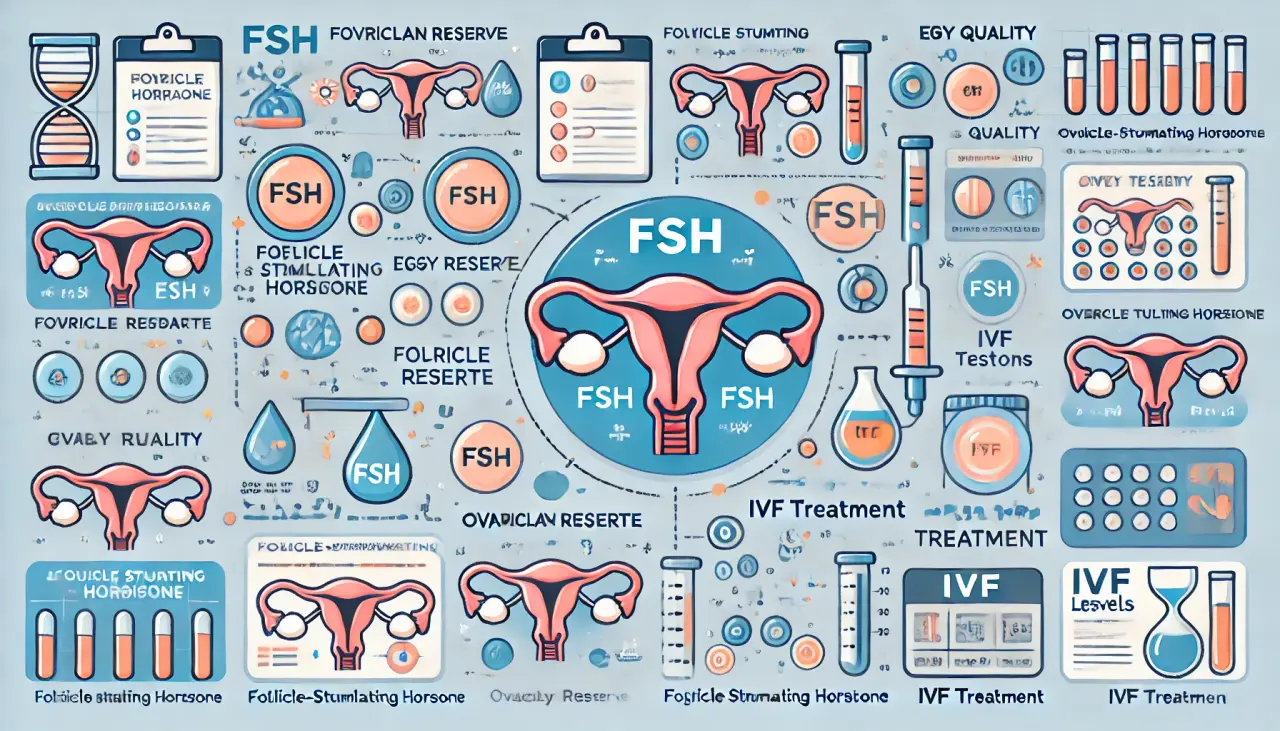
FSH and Its Role in IVF: Understanding Egg Quality and Follicle-Stimulating Hormone (FSH)
1. What is FSH?
Follicle-Stimulating Hormone (FSH) is a hormone secreted by the pituitary gland. It plays a crucial role in the female reproductive system by stimulating the growth and development of follicles in the ovaries, helping eggs mature and preparing them for potential fertilization. In simple terms, FSH acts as the “commander” for follicle growth, regulating the development of eggs. This hormone’s influence on egg quality and FSH levels is critical, especially for women undergoing IVF treatments.
2. The Close Link Between FSH and Ovarian Reserve
Ovarian reserve refers to the quantity and quality of a woman’s remaining eggs. FSH levels act as a “barometer” for ovarian reserve. Under normal circumstances, when the ovarian reserve is healthy, FSH levels remain stable and optimal, directing the development of the follicles in an orderly manner. However, as ovarian reserve declines—often due to aging or certain medical conditions—the number of eggs decreases. The body senses this change, and the pituitary gland increases FSH production to stimulate the ovaries to produce eggs, as if “urging” the ovaries to work harder. Thus, when FSH levels are elevated, it often signals that ovarian reserve may have diminished to some extent, affecting both egg quality and fertility outcomes in IVF.
3. The Critical Role of FSH Testing in IVF
3.1 Evaluating Ovarian Reserve
Before undergoing IVF treatment, doctors typically recommend FSH testing on days 2-4 of the menstrual cycle. This is an essential step in assessing ovarian reserve. By analyzing the FSH value, doctors can gain a preliminary understanding of the “stock” of eggs in the ovaries.
- If FSH levels are within a normal range, it indicates that the ovarian reserve is still functioning well. This gives doctors more confidence when devising an ovulation induction plan, allowing them to select the appropriate medication and dosage to maximize the chances of retrieving sufficient numbers of high-quality eggs.
- Conversely, if FSH levels are abnormally high, say, above 10-12 IU/L (reference ranges may vary between hospitals), it may suggest a reduced ovarian reserve, with fewer eggs and possibly compromised quality. In such cases, doctors will adjust the treatment plan, often opting for gentler, more personalized stimulation strategies. They will also prepare the patient for the potential challenges and shifts in success rates, ensuring the patient is well-informed and mentally prepared for potential changes in egg quality and FSH.
3.2 Predicting Response to Ovulation Stimulation
FSH levels not only reflect ovarian reserve but also help doctors predict how a patient might respond to ovulation-stimulation medications.
- For patients with lower FSH levels, their ovaries tend to be more sensitive to stimulation, and follicles may grow and mature rapidly after medication. In this case, doctors need to closely monitor follicular development and carefully adjust drug doses to prevent complications like Ovarian Hyperstimulation Syndrome (OHSS).
- On the other hand, for patients with higher FSH levels, their ovarian reserve is typically weaker, and the ovaries may not respond as well to ovulation-inducing drugs. These patients may need higher doses of medication to stimulate follicular growth, but even then, the number and quality of eggs retrieved may remain limited.
FSH testing, therefore, serves as a “compass” for doctors, guiding them in customizing the most appropriate ovulation stimulation plan for each patient to optimize IVF outcomes.
4. Interpreting FSH Test Results
4.1 Single vs. Multiple Tests
While a single FSH test provides some information, it may not be fully accurate on its own. FSH levels can fluctuate during the menstrual cycle, and results can also be affected by factors such as testing methods, timing, and individual variations. Therefore, relying on just one test result to assess ovarian reserve may not be the best approach.
Doctors usually recommend multiple FSH tests in conjunction with other tests, such as Estradiol (E2), Anti-Müllerian Hormone (AMH), and Antral Follicle Count (AFC), for a more comprehensive and reliable assessment of ovarian reserve. This multi-test approach provides a more accurate picture, allowing for a better-informed IVF treatment plan.
4.2 Monitoring FSH Trends
In addition to focusing on the specific FSH value, it is important to track its trends over time. If FSH levels show a gradual increase over a period of time—even if they are still within the normal range—it may indicate that ovarian reserve is slowly declining. This is particularly concerning for older patients or those with a higher risk of ovarian disease. Doctors will consider these trends and may recommend adjusting the treatment plan or encourage patients to start IVF treatment sooner to avoid missing the optimal time for conception.
Conclusion
In conclusion, FSH testing plays a pivotal role in the IVF process by offering insights into ovarian reserve and helping doctors personalize ovulation stimulation plans. By interpreting FSH levels in combination with other tests and monitoring changes over time, doctors can improve IVF success rates and provide tailored care that best meets the needs of each patient. Understanding the relationship between FSH and egg quality is essential for maximizing success in IVF treatments.